Monitoring Net Primary Productivity of Vegetation and Analyzing Its Drivers in Support of SDG Indicator 15.3.1: A Case Study of Northeast China
Abstract
:1. Introduction
2. Materials and Methods
2.1. Study Area
2.2. Dataset and Data Processing
2.2.1. Data for NPP Calculation
- Remote Sensing Data
- Meteorological Data
- Vegetation Type Data
2.2.2. Population Data
2.3. Methods
2.3.1. NPP Calculation and Validation
2.3.2. Adjustment of the WorldPop Dataset
2.3.3. Trend Analysis
2.3.4. Partial Correlation Analysis
2.3.5. Geographical Detector
3. Results
3.1. NPP Validation and Its Spatio-Temporal Distribution and Changes
3.1.1. Validation of NPP Results
3.1.2. Distribution and Changes of NPP by Vegetation Type
3.1.3. Spatial-Temporal Distribution and Changes of NPP at the Pixel Scale
3.2. Changes in Temperature and Precipitation
3.3. Spatial Distribution and Changes of Population
3.4. The Impact of Climate and Population Spatial Distribution Changes on Vegetation NPP
3.4.1. The Impact of Climate and Population Spatial Distribution Changes on Vegetation NPP at the Pixel Scale
3.4.2. The Degree of Climate and Population Influence on NPP by Vegetation Type
3.4.3. The Degree of Climate and Population Influence on NPP by Population Size
4. Discussion
4.1. Uncertainties in Methods and Data
4.2. Effect of Climate and Population Changes on Vegetation NPP
5. Conclusions
- From the perspective of NPP of various vegetation types, indicator 15.3.1 in the study area generally showed a favourable development from 2000 to 2020. From the perspective of NPP at the pixel scale, 7.19% of the areas that passed the test of significance showed no change or land degradation, which indicated that there were serious challenges to the achievement of target 15.3.1 in these regions, while 92.81% of the areas showed an improvement in the land situation, which indicated that indicator 15.3.1 made progress;
- The vegetation NPP in Northeast China in 2000–2020 was affected by the combined effects of temperature, precipitation and population. The effect of population spatial distribution on vegetation NPP showed spatial heterogeneity. It was feasible to use data on the spatial distribution of the population to mine the drivers of indicator 15.3.1 from a vegetation NPP perspective;
- The warming and wetting trend in Northeast China from 2000 to 2020 contributed to the accumulation of NPP in cultivated vegetation, thickets, steppes and grasslands. The response of NPP to temperature and precipitation in deciduous broad-leaved and deciduous coniferous forests varied according to geographical location;
- The vegetation NPP showed an increasing trend in both areas with higher population growth and areas with higher population decreases, and the former was likely the result of enhanced vegetation growth offsetting the loss of vegetation NPP due to larger population growth.
Author Contributions
Funding
Data Availability Statement
Acknowledgments
Conflicts of Interest
Appendix A

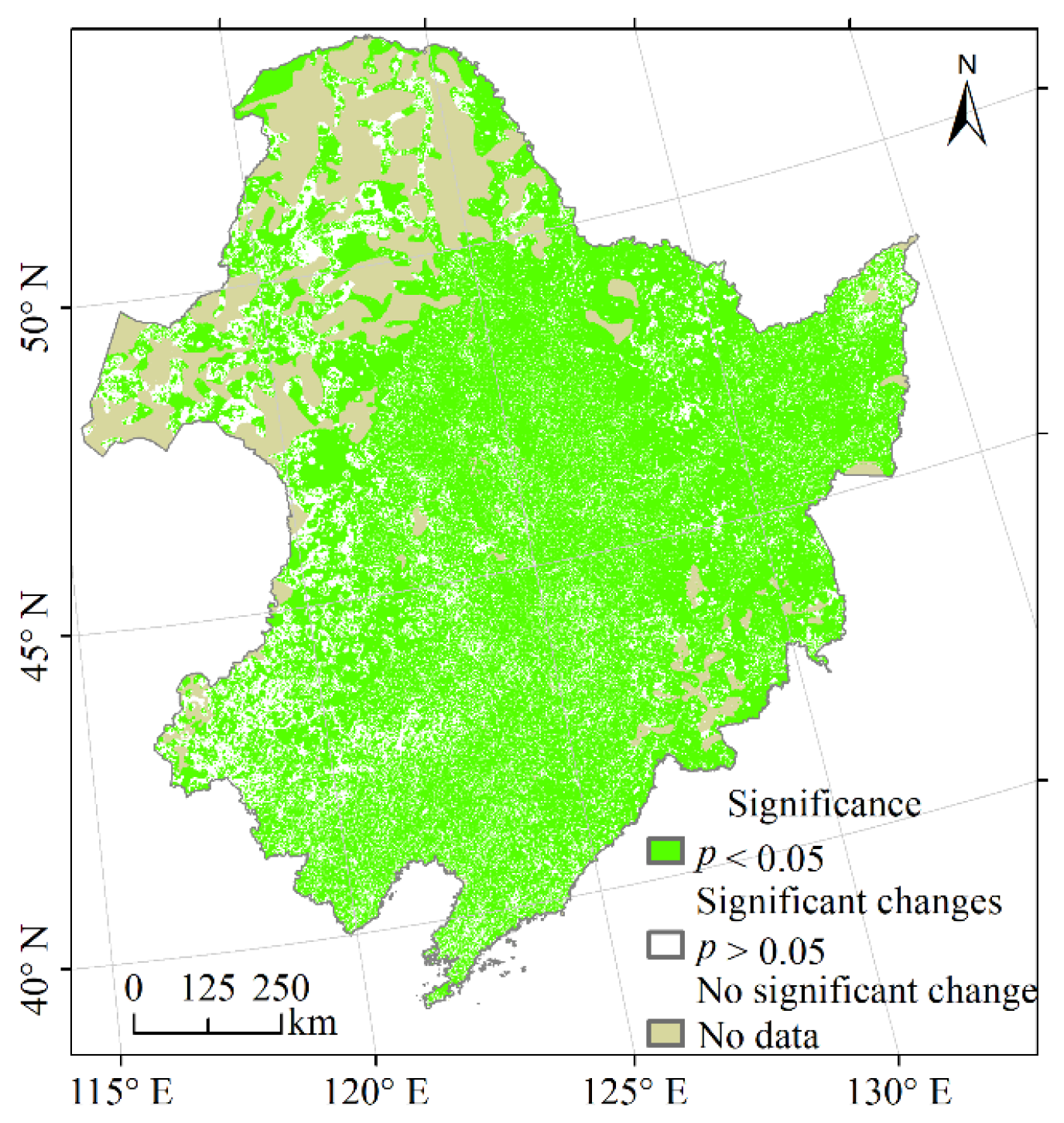
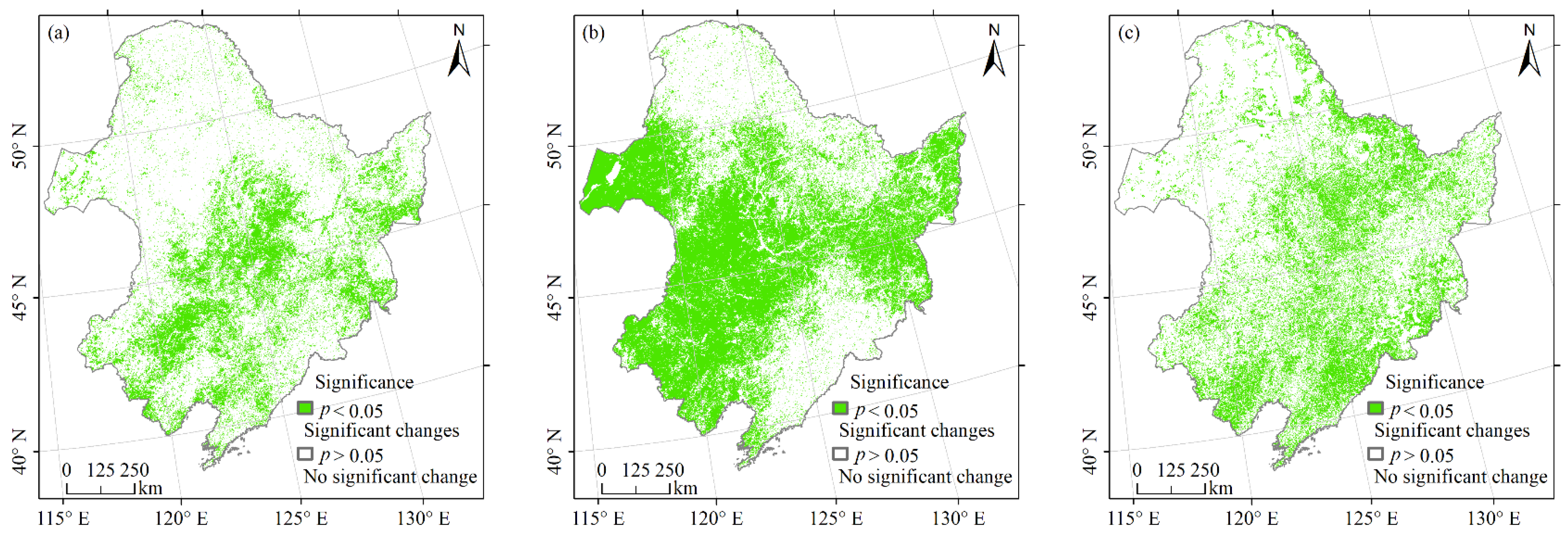


References
- United Nations. Transforming Our World: The 2030 Agenda for Sustainable Development; United Nations: New York, NY, USA, 2015. [Google Scholar]
- United Nations. Global Indicator Framework for the Sustainable Development Goals and Targets of the 2030 Agenda for Sustainable Development; United Nations: New York, NY, USA, 2023. [Google Scholar]
- Colglazier, W. Sustainable development agenda: 2030. Science 2015, 349, 1048–1050. [Google Scholar] [CrossRef] [PubMed]
- Chen, J.; Li, Z. Chinese pilot project tracks progress towards SDGs. Nature 2018, 563, 184. [Google Scholar] [CrossRef]
- Huan, Y.; Liang, T.; Li, H.; Zhang, C. A systematic method for assessing progress of achieving sustainable development goals: A case study of 15 countries. Sci. Total Environ. 2021, 752, 141875. [Google Scholar] [CrossRef]
- Jiang, L.; Bao, A.; Jiapaer, G.; Liu, R.; Yuan, Y.; Yu, T. Monitoring land degradation and assessing its drivers to support sustainable development goal 15.3 in Central Asia. Sci. Total Environ. 2022, 807, 150868. [Google Scholar] [CrossRef] [PubMed]
- Markos, A.; Sims, N.; Giuliani, G. Beyond the SDG 15.3.1 Good Practice Guidance 1.0 using the Google Earth Engine platform: Developing a self-adjusting algorithm to detect significant changes in water use efficiency and net primary production. Big Earth Data 2023, 7, 59–80. [Google Scholar] [CrossRef]
- Sims, N.C.; Newnham, G.J.; England, J.R.; Guerschman, J.; Cox, S.J.D.; Roxburgh, S.H.; Viscarra Rossel, R.A.; Fritz, S.; Wheeler, I. Good Practice Guidance. SDG Indicator 15.3.1, Proportion of Land That Is Degraded over Total Land Area. Version 2.0; United Nations Convention to Combat Desertification: Bonn, Germany, 2021. [Google Scholar]
- Field, C.B.; Behrenfeld, M.J.; Randerson, J.T.; Falkowski, P. Primary production of the biosphere: Integrating terrestrial and oceanic components. Science 1998, 281, 237–240. [Google Scholar] [CrossRef]
- Piao, S.; He, Y.; Wang, X.; Chen, F. Estimation of China’s terrestrial ecosystem carbon sink: Methods, progress and prospects. Sci. China Earth Sci. 2022, 65, 641–651. [Google Scholar] [CrossRef]
- Wang, T.; Giuliani, G.; Lehmann, A.; Jiang, Y.; Shao, X.; Li, L.; Zhao, H. Supporting SDG 15, life on land: Identifying the main drivers of land degradation in Honghe Prefecture, China, between 2005 and 2015. ISPRS Int. J. Geo-Inf. 2020, 9, 710. [Google Scholar] [CrossRef]
- Prince, S.D. Challenges for remote sensing of the Sustainable Development Goal SDG 15.3.1 productivity indicator. Remote Sens. Environ. 2019, 234, 111428. [Google Scholar] [CrossRef]
- Chu, C.; Bartlett, M.; Wang, Y.; He, F.; Weiner, J.; Chave, J.; Sack, L. Does climate directly influence NPP globally? Glob. Chang. Biol. 2016, 22, 12–24. [Google Scholar] [CrossRef]
- Kamali, A.; Khosravi, M.; Hamidianpour, M. Spatial–temporal analysis of net primary production (NPP) and its relationship with climatic factors in Iran. Environ. Monit. Assess. 2020, 192, 718. [Google Scholar] [CrossRef] [PubMed]
- Hao, L.; Wang, S.; Cui, X.; Zhai, Y. Spatiotemporal dynamics of vegetation net primary productivity and its response to climate change in Inner Mongolia from 2002 to 2019. Sustainability 2021, 13, 13310. [Google Scholar] [CrossRef]
- Overpeck, J.T.; Breshears, D.D. The growing challenge of vegetation change. Science 2021, 372, 786–787. [Google Scholar] [CrossRef] [PubMed]
- Lu, F.; Hu, H.; Sun, W.; Zhu, J.; Liu, G.; Zhou, W.; Zhang, Q.; Shi, P.; Liu, X.; Wu, X.; et al. Effects of national ecological restoration projects on carbon sequestration in China from 2001 to 2010. Proc. Natl. Acad. Sci. USA 2018, 115, 4039–4044. [Google Scholar] [CrossRef]
- Chen, T.; Peng, L.; Liu, S.; Wang, Q. Spatio-temporal pattern of net primary productivity in Hengduan Mountains area, China: Impacts of climate change and human activities. Chin. Geogr. Sci. 2017, 27, 948–962. [Google Scholar] [CrossRef]
- Yang, H.; Mu, S.; Li, J. Effects of ecological restoration projects on land use and land cover change and its influences on territorial NPP in Xinjiang, China. Catena 2014, 115, 85–95. [Google Scholar] [CrossRef]
- Zhou, W.; Gang, C.; Zhou, F.; Li, J.; Dong, X.; Zhao, C. Quantitative assessment of the individual contribution of climate and human factors to desertification in northwest China using net primary productivity as an indicator. Ecol. Indic. 2015, 48, 560–569. [Google Scholar] [CrossRef]
- Chen, T.; Bao, A.; Jiapaer, G.; Guo, H.; Zheng, G.; Jiang, L.; Chang, C.; Tuerhanjiang, L. Disentangling the relative impacts of climate change and human activities on arid and semiarid grasslands in Central Asia during 1982–2015. Sci. Total Environ. 2019, 653, 1311–1325. [Google Scholar] [CrossRef] [PubMed]
- Hu, Y.; Wang, C.; Yu, X.; Yin, S. Evaluating Trends of Land Productivity Change and Their Causes in the Han River Basin, China: In Support of SDG Indicator 15.3.1. Sustainability 2021, 13, 13664. [Google Scholar] [CrossRef]
- Bejagam, V.; Sharma, A. Impact of climatic changes and anthropogenic activities on ecosystem net primary productivity in India during 2001–2019. Ecol. Inform. 2022, 70, 101732. [Google Scholar] [CrossRef]
- Liu, H.; Jiao, F.; Yin, J.; Li, T.; Gong, H.; Wang, Z.; Lin, Z. Nonlinear relationship of vegetation greening with nature and human factors and its forecast—A case study of Southwest China. Ecol. Indic. 2020, 111, 106009. [Google Scholar] [CrossRef]
- Qi, X.; Jia, J.; Liu, H.; Lin, Z. Relative importance of climate change and human activities for vegetation changes on China’s silk road economic belt over multiple timescales. Catena 2019, 180, 224–237. [Google Scholar] [CrossRef]
- Ge, W.; Deng, L.; Wang, F.; Han, J. Quantifying the contributions of human activities and climate change to vegetation net primary productivity dynamics in China from 2001 to 2016. Sci. Total Environ. 2021, 773, 145648. [Google Scholar] [CrossRef] [PubMed]
- Teng, M.; Zeng, L.; Hu, W.; Wang, P.; Yan, Z.; He, W.; Zhang, Y.; Huang, Z.; Xiao, W. The impacts of climate changes and human activities on net primary productivity vary across an ecotone zone in Northwest China. Sci. Total Environ. 2020, 714, 136691. [Google Scholar] [CrossRef] [PubMed]
- Yin, L.; Dai, E.; Zheng, D.; Wang, Y.; Ma, L.; Tong, M. What drives the vegetation dynamics in the Hengduan Mountain region, southwest China: Climate change or human activity? Ecol. Indic. 2020, 112, 106013. [Google Scholar] [CrossRef]
- Qiu, Y.; Zhao, X.; Fan, D.; Li, S.; Zhao, Y. Disaggregating population data for assessing progress of SDGs: Methods and applications. Int. J. Digit. Earth 2022, 15, 2–29. [Google Scholar] [CrossRef]
- Lloyd, C.T.; Sorichetta, A.; Tatem, A.J. High resolution global gridded data for use in population studies. Sci. Data 2017, 4, 170001. [Google Scholar] [CrossRef] [PubMed]
- Tatem, A.J. WorldPop, open data for spatial demography. Sci. Data 2017, 4, 170004. [Google Scholar] [CrossRef] [PubMed]
- Wang, J.; Zhang, T.; Fu, B. A measure of spatial stratified heterogeneity. Ecol. Indic. 2016, 67, 250–256. [Google Scholar] [CrossRef]
- Wang, Y.; Zhang, Z.; Chen, X. Quantifying influences of natural and anthropogenic factors on vegetation changes based on geodetector: A case study in the Poyang Lake Basin, China. Remote Sens. 2021, 13, 5081. [Google Scholar] [CrossRef]
- Li, H.; Zhang, H.; Li, Q.; Zhao, J.; Guo, X.; Ying, H.; Deng, G.; Rihan, W.; Wang, S. Vegetation productivity dynamics in response to climate change and human activities under different topography and land cover in Northeast China. Remote Sens. 2021, 13, 975. [Google Scholar] [CrossRef]
- Zhu, W.; Pan, Y.; Liu, X.; Wang, A. Spatio-temporal distribution of net primary productivity along the Northeast China Transect and its response to climatic change. J. For. Res. 2006, 17, 93–98. [Google Scholar] [CrossRef]
- Workneh, H.T.; Chen, X.; Ma, Y.; Bayable, E.; Dash, A. Comparison of IDW, Kriging and orographic based linear interpolations of rainfall in six rainfall regimes of Ethiopia. J. Hydrol. Reg. Stud. 2024, 52, 101696. [Google Scholar] [CrossRef]
- Zhang, X.S. Vegetation Map of the People’s Republic of China (1:1 000 000); Geology Press: Beijing, China, 2007. [Google Scholar]
- Potter, C.S.; Randerson, J.T.; Field, C.B.; Matson, P.A.; Vitousek, P.M.; Mooney, H.A.; Klooster, S.A. Terrestrial ecosystem production: A process model based on global satellite and surface data. Glob. Biogeochem. Cycles 1993, 7, 811–841. [Google Scholar] [CrossRef]
- Zhu, W.; Pan, Y.; Zhang, J. Estimation of net primary productivity of Chinese terrestrial vegetation based on remote sensing. Chin. J. Plant Ecol. 2007, 31, 413–424. [Google Scholar]
- Sun, J.; Yue, Y.; Niu, H. Evaluation of NPP using three models compared with MODIS-NPP data over China. PLoS ONE 2021, 16, e252149. [Google Scholar] [CrossRef] [PubMed]
- Center for International Earth Science Information Network (CIESIN), Columbia University. Documentation for the Gridded Population of the World, Version 4 (GPWv4), Revision 11 Data Sets; NASA Socioeconomic Data and Applications Center (SEDAC): Palisades, NY, USA, 2018. [Google Scholar]
- Hathout, D. Modeling population growth: Exponential and hyperbolic modeling. Appl. Math. 2013, 4, 299–304. [Google Scholar] [CrossRef]
- Li, Y.; Qin, Y. The response of net primary production to climate change: A case study in the 400 mm annual precipitation fluctuation zone in China. Int. J. Environ. Res. Public Health 2019, 16, 1497. [Google Scholar] [CrossRef] [PubMed]
- Yan, M.; Xue, M.; Zhang, L.; Tian, X.; Chen, B.; Dong, Y. A decade’s change in vegetation productivity and its response to climate change over Northeast China. Plants 2021, 10, 821. [Google Scholar] [CrossRef] [PubMed]
- Mao, D.; Wang, Z.; Wu, C.; Song, K.; Ren, C. Examining forest net primary productivity dynamics and driving forces in northeastern China during 1982–2010. Chin. Geogr. Sci. 2014, 24, 631–646. [Google Scholar] [CrossRef]
- Li, T.; Wang, W.; Deng, L. Analysis of urbanization, industrialization and population agglomeration in Northeast China based on PVAR model. Popul. J. 2018, 40, 75–85. [Google Scholar] [CrossRef]
- Jiao, W.; Chen, Y.; Li, W.; Zhu, C.; Li, Z. Estimation of net primary productivity and its driving factors in the Ili River Valley, China. J. Arid Land 2018, 10, 781–793. [Google Scholar] [CrossRef]
- Turner, D.P.; Ritts, W.D.; Cohen, W.B.; Gower, S.T.; Running, S.W.; Zhao, M.; Costa, M.H.; Kirschbaum, A.A.; Ham, J.M.; Saleska, S.R.; et al. Evaluation of MODIS NPP and GPP products across multiple biomes. Remote Sens. Environ. 2006, 102, 282–292. [Google Scholar] [CrossRef]
- Zhang, F.; Zhou, G. Spatial-temporal variations in net primary productivity along Northeast China transect (NECT) from 1982 to 1999. Chin. J. Plant Ecol. 2008, 32, 798–809. [Google Scholar] [CrossRef]
- Liang, W.; Yang, Y.; Fan, D.; Guan, H.; Zhang, T.; Long, D.; Zhou, Y.; Bai, D. Analysis of spatial and temporal patterns of net primary production and their climate controls in China from 1982 to 2010. Agric. For. Meteorol. 2015, 204, 22–36. [Google Scholar] [CrossRef]
- Stevens, F.R.; Gaughan, A.E.; Linard, C.; Tatem, A.J. Disaggregating census data for population mapping using random forests with remotely-sensed and ancillary data. PLoS ONE 2015, 10, e107042. [Google Scholar] [CrossRef] [PubMed]
- Nagle, N.N.; Buttenfield, B.P.; Leyk, S.; Spielman, S. Dasymetric modeling and uncertainty. Ann. Assoc. Am. Geogr. 2014, 104, 80–95. [Google Scholar] [CrossRef] [PubMed]
- Wang, S.; Tian, Y.; Zhou, Y.; Liu, W.; Lin, C. Fine-Scale Population Estimation by 3D Reconstruction of Urban Residential Buildings. Sensors 2016, 16, 1755. [Google Scholar] [CrossRef] [PubMed]
- Wang, J.; Hu, Y. Environmental health risk detection with GeogDetector. Environ. Modell. Softw. 2012, 33, 114–115. [Google Scholar] [CrossRef]
- Wang, X.; Sun, Y.; Guo, H.; Wang, H. Analysis of soil heavy metal Hg pollution source based on GeoDetector. Pol. J. Environ. Stud. 2022, 31, 347–355. [Google Scholar] [CrossRef]
- Wheeler, D.C.; Páez, A. Geographically weighted regression. In Handbook of Applied Spatial Analysis: Software Tools, Methods and Applications; Fischer, M.M., Getis, A., Eds.; Springer: Berlin/Heidelberg, Germany, 2010; pp. 461–486. [Google Scholar]
- Guo, B.; Han, B.; Yang, F.; Chen, S.; Liu, Y.; Yang, W. Determining the contributions of climate change and human activities to the vegetation NPP dynamics in the Qinghai-Tibet Plateau, China, from 2000 to 2015. Environ. Monit. Assess. 2020, 192, 663. [Google Scholar] [CrossRef]
- Committee for the Compilation of the Northeast Regional Climate Change Assessment Report (2020). Northeast Regional Climate Change Assessment Report: Summary for Policymakers 2020; China Meteorological Press: Beijing, China, 2021. [Google Scholar]
- Fang, J.; Piao, S.; Zhou, L.; He, J.; Wei, F.; Myneni, R.B.; Tucker, C.J.; Tan, K. Precipitation patterns alter growth of temperate vegetation. Geophys. Res. Lett. 2005, 32, L21411. [Google Scholar] [CrossRef]
- Munson, S.M.; Bunting, E.L.; Bradford, J.B.; Butterfield, B.J.; Gremer, J.R. Plant production responses to precipitation differ along an elevation gradient and are enhanced under extremes. Ecosystems 2019, 22, 699–708. [Google Scholar] [CrossRef]
- Peng, S.; Piao, S.; Wang, T.; Sun, J.; Shen, Z. Temperature sensitivity of soil respiration in different ecosystems in China. Soil Biol. Biochem. 2009, 41, 1008–1014. [Google Scholar] [CrossRef]
- Liu, Q.; Fu, Y.H.; Zhu, Z.; Liu, Y.; Liu, Z.; Huang, M.; Janssens, I.A.; Piao, S. Delayed autumn phenology in the Northern Hemisphere is related to change in both climate and spring phenology. Glob. Chang. Biol. 2016, 22, 3702–3711. [Google Scholar] [CrossRef] [PubMed]
- Wu, X.; Liu, H.; Li, X.; Piao, S.; Ciais, P.; Guo, W.; Yin, Y.; Poulter, B.; Peng, C.; Viovy, N.; et al. Higher temperature variability reduces temperature sensitivity of vegetation growth in Northern Hemisphere. Geophys. Res. Lett. 2017, 44, 6173–6181. [Google Scholar] [CrossRef]
- Zhang, L.; Yang, L.; Zohner, C.M.; Crowther, T.W.; Li, M.; Shen, F.; Guo, M.; Qin, J.; Yao, L.; Zhou, C. Direct and indirect impacts of urbanization on vegetation growth across the world’s cities. Sci. Adv. 2022, 8, o95. [Google Scholar] [CrossRef] [PubMed]
- Huang, B.; Lu, F.; Wang, X.; Wu, X.; Zhang, L.; Ouyang, Z. Ecological restoration and rising CO2 enhance carbon sink, counteracting climate change in northeastern China. Environ. Res. Lett. 2021, 17, 014002. [Google Scholar] [CrossRef]
- Tang, Z.; Ma, J.; Peng, H.; Wang, S.; Wei, J. Spatiotemporal changes of vegetation and their responses to temperature and precipitation in upper Shiyang river basin. Adv. Space Res. 2017, 60, 969–979. [Google Scholar] [CrossRef]
- Chen, Y.; Mei, L. Quantitative analysis of population distribution and influencing factors of resource-based cities in Northeast China. Sci. Geogr. Sin. 2018, 38, 402–409. [Google Scholar] [CrossRef]
- You, H.; Yang, J.; Xue, B.; Xiao, X.; Xia, J.; Jin, C.; Li, X. Spatial evolution of population change in Northeast China during 1992–2018. Sci. Total Environ. 2021, 776, 146023. [Google Scholar] [CrossRef]
- Luo, Z.; Wu, W.; Yu, X.; Song, Q.; Yang, J.; Wu, J.; Zhang, H. Variation of net primary production and its correlation with climate change and anthropogenic activities over the Tibetan Plateau. Remote Sens. 2018, 10, 1352. [Google Scholar] [CrossRef]

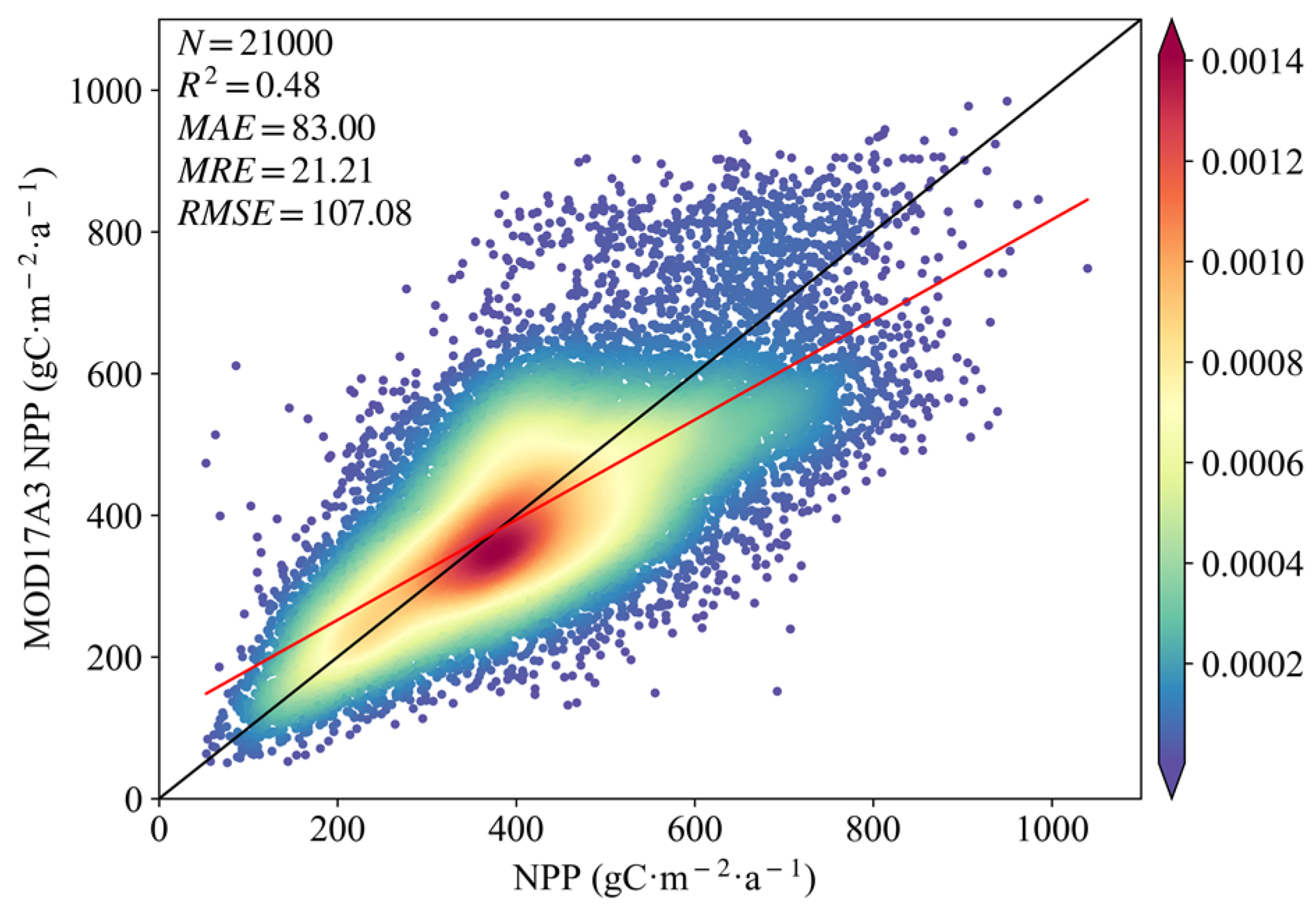


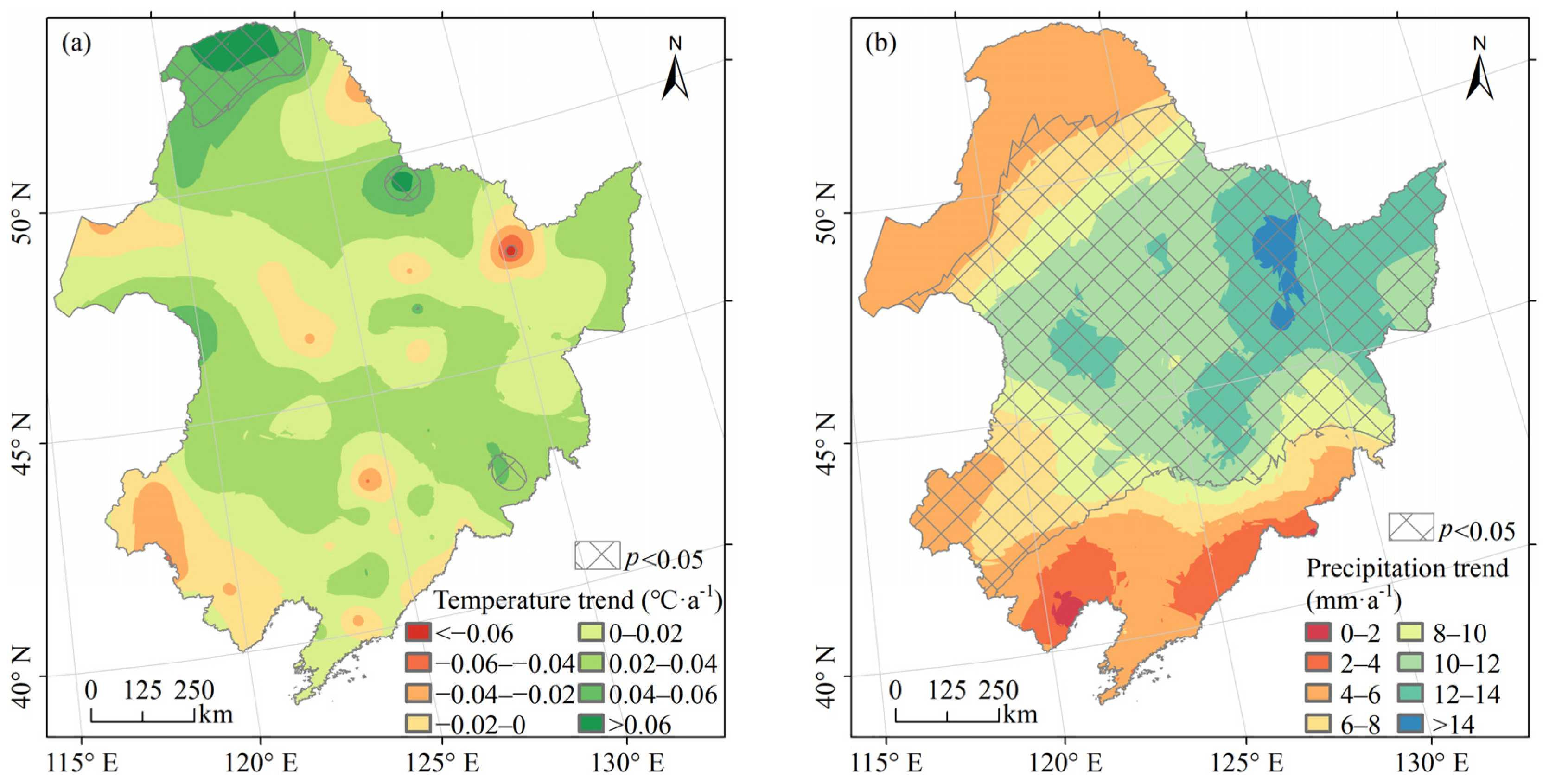

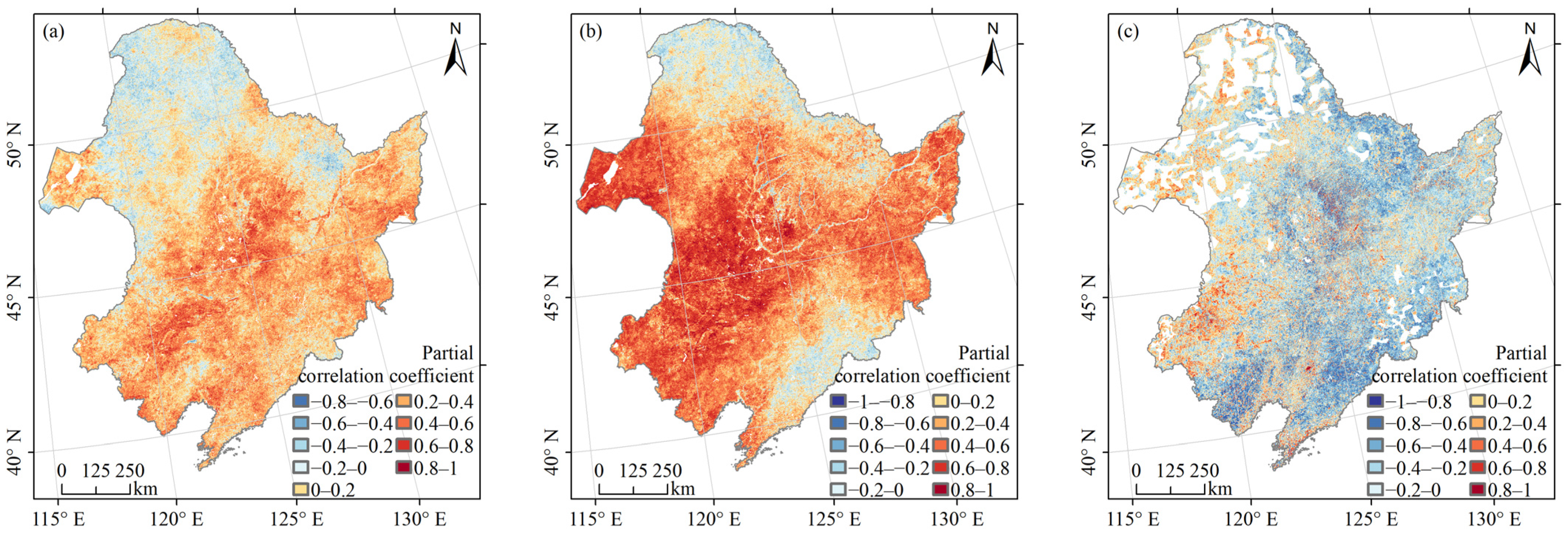




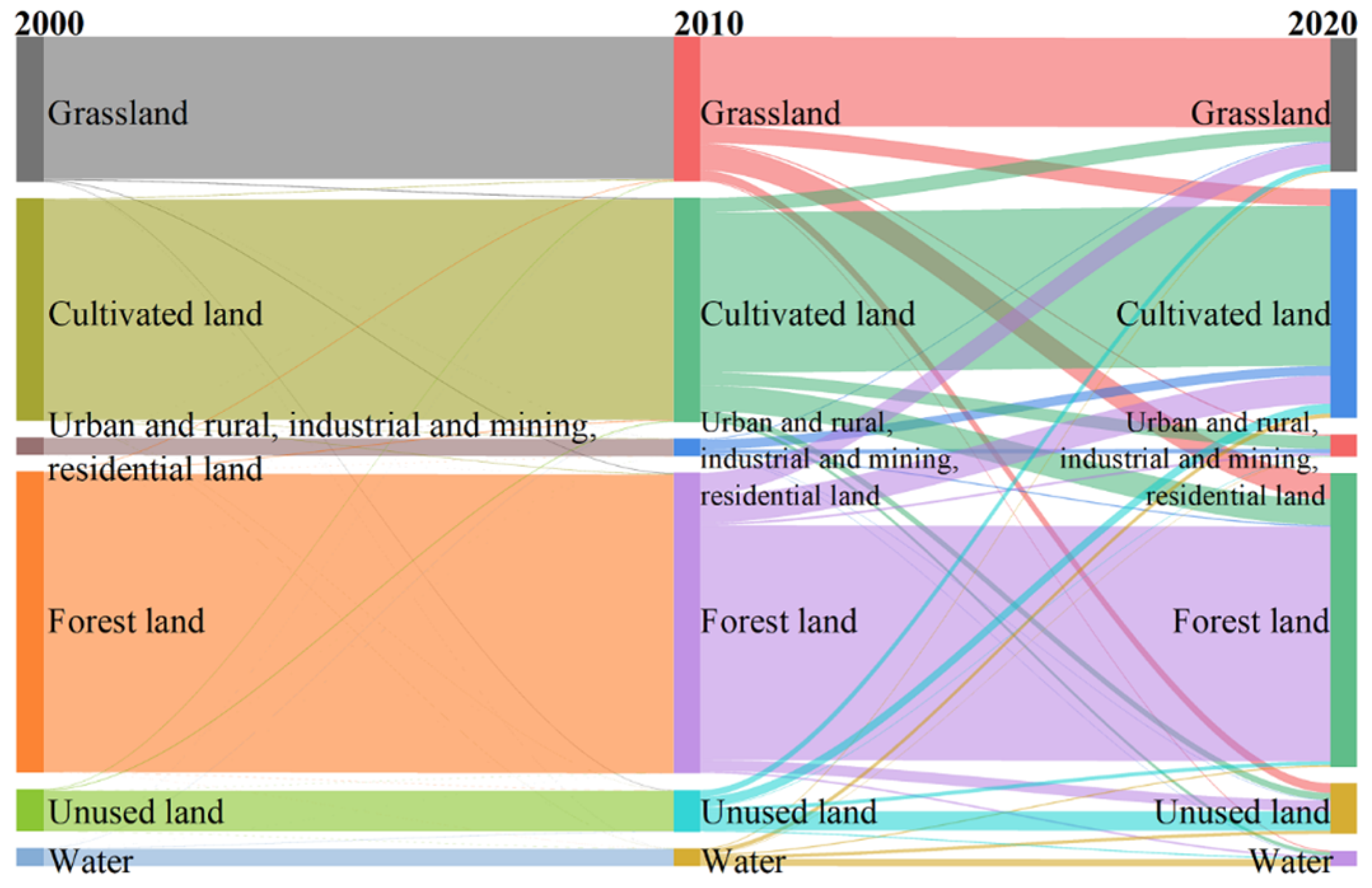
Disclaimer/Publisher’s Note: The statements, opinions and data contained in all publications are solely those of the individual author(s) and contributor(s) and not of MDPI and/or the editor(s). MDPI and/or the editor(s) disclaim responsibility for any injury to people or property resulting from any ideas, methods, instructions or products referred to in the content. |
© 2024 by the authors. Licensee MDPI, Basel, Switzerland. This article is an open access article distributed under the terms and conditions of the Creative Commons Attribution (CC BY) license (https://creativecommons.org/licenses/by/4.0/).
Share and Cite
Qiu, Y.; Zhao, X.; Fan, D.; Zheng, Z.; Zhang, Y.; Zhang, J. Monitoring Net Primary Productivity of Vegetation and Analyzing Its Drivers in Support of SDG Indicator 15.3.1: A Case Study of Northeast China. Remote Sens. 2024, 16, 2455. https://doi.org/10.3390/rs16132455
Qiu Y, Zhao X, Fan D, Zheng Z, Zhang Y, Zhang J. Monitoring Net Primary Productivity of Vegetation and Analyzing Its Drivers in Support of SDG Indicator 15.3.1: A Case Study of Northeast China. Remote Sensing. 2024; 16(13):2455. https://doi.org/10.3390/rs16132455
Chicago/Turabian StyleQiu, Yue, Xuesheng Zhao, Deqin Fan, Zhoutao Zheng, Yuhan Zhang, and Jinyu Zhang. 2024. "Monitoring Net Primary Productivity of Vegetation and Analyzing Its Drivers in Support of SDG Indicator 15.3.1: A Case Study of Northeast China" Remote Sensing 16, no. 13: 2455. https://doi.org/10.3390/rs16132455




